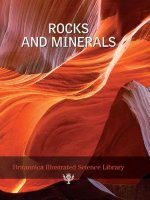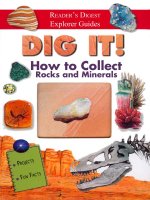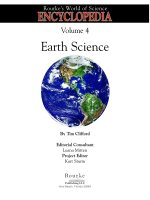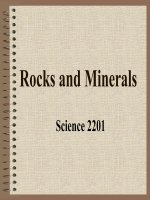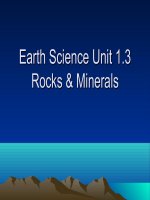4 8 rocks and minerals (earth science)
Bạn đang xem bản rút gọn của tài liệu. Xem và tải ngay bản đầy đủ của tài liệu tại đây (3.73 MB, 10 trang )
Genre
Nonfiction
Comprehension Skill
Summarize
Text Features
•
•
•
•
Charts
Captions
Diagrams
Glossary
Science Content
Rocks and
Minerals
Scott Foresman Science 4.8
ISBN 0-328-13881-9
ì<(sk$m)=bdi be< +^-Ä-U-Ä-U
Vocabulary
igneous rock
luster
metamorphic rock
mineral
sediment
sedimentary rock
weathering
What did you learn?
1. What are some of the words used to
describe a mineral’s luster?
2. How do fossils help scientists figure out
the age of a layer of rock?
3. What is magma?
4.
Rocks can
have
by Mary
Miller
different forms during the rock cycle.
Write to explain how rocks change from
one form to another. Include details from
the book to support your answer.
5.
Picture Credits
Every effort has been made to secure permission and provide appropriate credit for photographic material.
The publisher deeply regrets any omission and pledges to correct errors called to its attention in subsequent editions.
Photo locators denoted as follows: Top (T), Center (C), Bottom (B), Left (L), Right (R), Background (Bkgd).
15 Digital Stock.
Unless otherwise acknowledged, all photographs are the copyright © of Dorling Kindersley, a division of Pearson.
ISBN: 0-328-13881-9
Copyright © Pearson Education, Inc. All Rights Reserved. Printed in the United States of America.
This publication is protected by Copyright, and permission should be obtained from the publisher prior to any
prohibited reproduction, storage in a retrieval system, or transmission in any form by any means, electronic,
mechanical, photocopying, recording, or likewise. For information regarding permission(s), write to
Permissions Department, Scott Foresman, 1900 East Lake Avenue, Glenview, Illinois 60025.
3 4 5 6 7 8 9 10 V010 13 12 11 10 09 08 07 06 05
Summarize Explain the main
differences between sedimentary,
igneous, and metamorphic rocks.
Minerals
Earth’s crust is made of a
layer of rocks. All rocks are
made of minerals.
calcite
garnet
Scientists have identified more than three thousand
minerals. Each mineral has crystals that form a unique
shape. For example, a quartz crystal is six-sided, similar
to the shape of your pencil. Topaz crystals can be very
large. Some weigh over two hundred pounds.
A mineral has the same chemical makeup no matter
where it forms. Sulfur found in Florida has the same
chemicals as sulfur found in Hawaii.
About thirty minerals are found in Earth’s crust.
These minerals are called the rock-forming minerals.
Each kind of rock is made of a different mix of
minerals. For example, hornblende granite is always
made of feldspar, quartz, and mica. Some types of rock
have only one or two minerals. A type of coal called
anthracite is nearly all carbon.
feldspar
yellow sulfur
Mineral Crystals
opal
Minerals are part of our everyday lives. The milk
you drink contains a mineral called calcium that
builds strong bones and teeth. The dirt in your school
playground has minerals in it. Minerals are nonliving
solid crystals that make up rocks. Minerals are not made
by humans but are found in nature.
2
hornblende granite
quartz
mica
3
Mohs Scale for Hardness
9
10
co
ru
nd
um
di
am
on
d
to
pa
z
tz
qu
ar
ld
sp
ar
ite
ap
at
e
8
7
Hardness
rock crystal
Color
Color is the most obvious property of a mineral
because it is easy to see. However, a color test has
limitations. Some minerals come in many different
colors. For example, quartz can be purple, yellow, pink,
or brown. Another problem is that many minerals are
the same color, or even colorless.
Luster
Scientists also study a mineral’s luster. Luster is the
way a mineral’s surface reflects light. The luster can be
dull, metallic, pearly, glassy, greasy, or silky. A quartz
rock crystal has a glassy luster. In contrast, pyrite has a
metallic luster. Most minerals have a glassy luster.
4
6
5
4
fe
smoky
quartz
3
2
flu
or
it
lc
gy
ps
um
ta
Quartz can be many different colors.
citrine
1
ci
te
Scientists use different tests to tell one mineral from
another. They test its physical properties, such as color,
luster, hardness, streak, and cleavage.
ca
l
Identifying Minerals
A mineral’s hardness is how easily it can be
scratched. Scientists measure hardness using a chart
called the Mohs Scale for Hardness. The scale ranks
minerals from 1 to 10. A mineral with a high number
can scratch all minerals lower on the scale. For example,
a diamond is a 10. Feldspar is a 6. If a diamond is
rubbed against a piece of feldspar, the diamond will
scratch the feldspar.
Streak
The streak test is another way to tell minerals apart.
A mineral is scratched across a special kind of plate. The
color of the powder left behind is the mineral’s streak.
Even though minerals can come in many colors,
a mineral’s streak will always be the same color. For
example, fluorite can look yellow, green, blue, purple,
or even black. But its streak is always white. The streak
test is one way to tell gold from “fool’s gold,” or pyrite.
Real gold leaves a yellow streak. Pyrite leaves a greenish
black streak.
5
Sedimentary Rocks
Rock is always changing. Mountains and rocks are
battered by natural forces. Rain, wind, and ice break
down rocks into mineral particles. These particles are
tossed together with bits of shells and soil. Dead plant
and animal remains are also swept into this mix.
Wind, running water, and gravity move these
particles from one place to another. This is erosion.
The eroded material that settles at the bottoms of lakes,
rivers, and oceans is called sediment.
The particles in sediment have different sizes and
shapes. Some are smooth, while others have sharp edges.
Ice wears
away rock.
Rivers carry
bits of rock
into the ocean.
kinds of
sedimentary
rocks
shale
limestone
sandstone
Rock Layers
Over time, new sediment flows over the old rock
particles. The new layers press down on the older layers.
The weight of the layers helps to cement the particles
together. They harden and form sedimentary rock. The
kind of sedimentary rock that is made depends on what
makes up the sediment.
Kinds of Sedimentary Rocks
Wind wears
away rock.
Rock settles at the
bottom of the ocean.
6
Most sedimentary rocks are formed by erosion.
Rocks are broken down and moved to new places.
These bits are cemented together to form new rocks.
Sandstone can start with tiny quartz grains that are
round in shape and uniform in size. The quartz mixes
with grains of feldspar and sand. These tiny grains are
glued together with bits of silica, calcite, or iron.
7
Some sedimentary
rocks are formed in
part from the remains
of plants and animals.
Most fossils are found in
sedimentary rocks. When
fish and other sea animals
die, their bodies fall to
the ocean floor. Their
hard skeletons and shells
are saved in the layers
of sediment. Calcite
and other dissolved
minerals cement these
layers together to create
limestone.
How Rocks Become Soil
When an
animal dies,
it may sink
to the ocean
floor.
It may
become
buried
in the
sediment.
Soft parts
of the
animal
decay, but
hard parts
are left.
The fossil
becomes part of
the rock around it.
The soil at your local park was once a large rock—or
even part of a mountain. Over time, rocks are broken
apart by heat and cold. Rainwater drips through cracks
in the rock and freezes. When the ice thaws, it leaves
behind even larger cracks. Deep-rooted plants can also
dig into rocks and create grooves and cracks.
Eventually, pieces of rock break off. These pieces are
blown or washed away. This battering of rock by natural
forces is called weathering. Over millions of years, even
mountains can be worn down to a pile of rocks.
These bits of weathered rock mix with decayed
plants and animals to form soil. Soil contains living
things, such as insects, bacteria, and fungi. These life
forms make nutrients to help plants grow.
Sometimes clay hardens into sedimentary rock.
Tiny particles of clay settle at the bottoms of oceans
and lakes. Over time these minerals harden to form
mudstone or shale. Mudstone contains quartz, feldspar,
and mica. It is used to make bricks and cement.
Chemicals in shale can be
used to make fuel and other
products.
Mudstone
8
9
How Fossils Develop
Fossils are found in layers of rock. The age of a fossil
can help scientists figure out the age of the rock layer.
The Archaeopteryx had feathers like a bird but teeth
and a tail like those of a reptile. It lived about 150 million
years ago. An Archaeopteryx fossil found in a layer of rock
means the layer formed in that time period. Scientists
study fossils in rock layers to learn how animals and
plants have changed over time.
dinosaur eggs
What Rocks Can Tell Us
Some sedimentary rocks contain fossilized remains
of life forms that existed millions of years ago. Many
animals that once roamed Earth no longer exist. Fossils
are our only record that they ever existed. Fossils give
scientists clues about Earth’s history. They show how
prehistoric plants and animals lived.
Scientists might find fossilized footprints made by
a dinosaur 100 million years ago. The distance between
the footprints can tell scientists how fast the dinosaur
could move. Fossils also give clues about prehistoric
animal behavior. The discovery of fossilized nest eggs
revealed that some dinosaurs laid eggs and took care
of their young. Fossils of teeth can tell scientists if the
animal was a meat or plant eater.
10
Cenozoic Era (65 million years ago to
present)—Fossils show that large mammals
and earliest humans appeared.
Mesozoic Era (248 million to 65 million years
ago)—Fossil evidence of dinosaurs is found in
the rocks of this era. This is when dinosaurs
became extinct.
Paleozoic Era (544 million to 248 million years
ago)—Fossils of early reptiles, insects, and fish
are found in these rocks.
Precambrian Era (more than 544 million years ago)—
Life appeared. Rocks from this era have fossils of
early jellyfish.
Scientists use a geologic time scale to divide Earth’s
history into time periods called eras. The earliest era is
at the bottom of the chart. This order shows the ages of
the layers of sedimentary rock. The oldest fossils are in
the bottom layers.
11
Igneous And
Metamorphic Rocks
Sedimentary rocks are not the only kinds of rock
found on Earth. The two other kinds are igneous rocks
and metamorphic rocks.
Igneous Rocks
Many rocks are hard and can be broken into pieces.
Sometimes rock melts. This is what happens to the
layer of rock deep below Earth’s crust, where it is very
hot. This molten rock is magma. Igneous rock forms
from molten rock. Most of the ocean floor is a type of
igneous rock named basalt.
Igneous rocks can form above or below Earth’s
surface. Sometimes hot magma explodes out of Earth’s
crust when a volcano erupts. Magma that reaches Earth’s
surface is called lava. The lava may stream down the
sides of a volcano in a red-hot river. It can also be flung
out of the volcano in hot chunks. Lava cools quickly on
the surface. It can harden into solid rock in a few days.
Most igneous rock, however, does not form this way.
The magma slowly rises. It fills cracks in Earth’s crust.
As the magma cools and hardens, mineral crystals form
in the rock. The hardening of magma into igneous rock
within Earth can take a very long time.
12
The Giant’s Causeway
A causeway is a road built over water. Stone pillars
may hold up these roads. The Giant’s Causeway is a
natural formation of basalt columns on the coast of
Northern Ireland. Nearly forty thousand pillars lead
from the cliffs to the sea. Some reach a height of more
than forty feet. Many of the columns are six-sided.
The columns are 50 to 60 million years old. As flowing
lava reached the sea, it cooled rapidly. As it
cooled, pressure on the lava caused
it to squeeze together. Cracks
split the rock from top to
bottom and formed
the pillars.
13
The Rock Cycle
zeolite crystals
Marble forms
from limestone.
Metamorphic Rocks
Over millions of years, rocks in Earth’s crust are
squeezed by the weight of other rocks. This can cause
rocks to change. Some rocks begin to melt. Rock that
is changed by heat and pressure is called metamorphic
rock. It has undergone a metamorphosis, or a change
in form.
Sedimentary and igneous rock can change into
metamorphic rock. Limestone is a sedimentary rock.
Pressure deep below Earth’s surface can turn it into
marble. The igneous rock shale can become slate.
Metamorphic rocks change in many ways as they are
formed. The rocks’ mineral crystals can change. They
may become new crystals that have a different size or
shape. Sometimes the minerals settle in layers as a result
of heat and pressure. This can cause some metamorphic
rocks to break into flat slabs.
14
The rock cycle is the process in which old rocks
recycle into new ones. Heat, pressure, weathering, and
erosion help keep the rock cycle going.
Sedimentary, igneous, and metamorphic rocks can
all change into a different kind of rock at any time.
Metamorphic rock can melt into magma and later
become igneous rock when the lava cools. Igneous rock
can wear away, and its pieces can become sedimentary
rock.
All three kinds of rocks are made of minerals. These
minerals have many properties that can be used to
describe them. Different combinations of minerals form
different kinds of rocks. The next time you see a rock,
think about how many changes it will go through as it
moves through the rock cycle.
15
What did you learn?
Vocabulary
Glossary
igneous rock
luster
metamorphic
igneous
rock rock
mineral
sediment
sedimentary rock
weathering
luster
rock that is formed when
magma or lava cools and
hardens
the way a mineral’s surface
reflects light
metamorphic rock
rock changed by great heat and
pressure inside Earth
mineral
a naturally occurring,
nonliving crystal that makes
up rocks
sediment
the eroded material that settles
on the bottoms of lakes,
rivers, and oceans
Picture Credits
Every effort has been made to secure permission and provide appropriate credit for photographic material.
The publisher deeply regrets any omission and pledges to correct errors called to its attention in subsequent editions.
sedimentary rock
rock created as layers of
sediment are weighed down
15 Digital Stock.
and
hardened
together
Unless otherwise acknowledged, all photographs
are the
copyright © of Dorling
Kindersley, a division of Pearson.
Photo locators denoted as follows: Top (T), Center (C), Bottom (B), Left (L), Right (R), Background (Bkgd).
weathering
ISBN: 0-328-13881-9
the battering of rocks by wind,
rain, heat, and ice
Copyright © Pearson Education, Inc. All Rights Reserved. Printed in the United States of America.
This publication is protected by Copyright, and permission should be obtained from the publisher prior to any
prohibited reproduction, storage in a retrieval system, or transmission in any form by any means, electronic,
mechanical, photocopying, recording, or likewise. For information regarding permission(s), write to
Permissions Department, Scott Foresman, 1900 East Lake Avenue, Glenview, Illinois 60025.
3 4 5 6 7 8 9 10 V010 13 12 11 10 09 08 07 06 05
16
1. What are some of the words used to
describe a mineral’s luster?
2. How do fossils help scientists figure out
the age of a layer of rock?
3. What is magma?
4.
Rocks can have
different forms during the rock cycle.
Write to explain how rocks change from
one form to another. Include details from
the book to support your answer.
5.
Summarize Explain the main
differences between sedimentary,
igneous, and metamorphic rocks.
